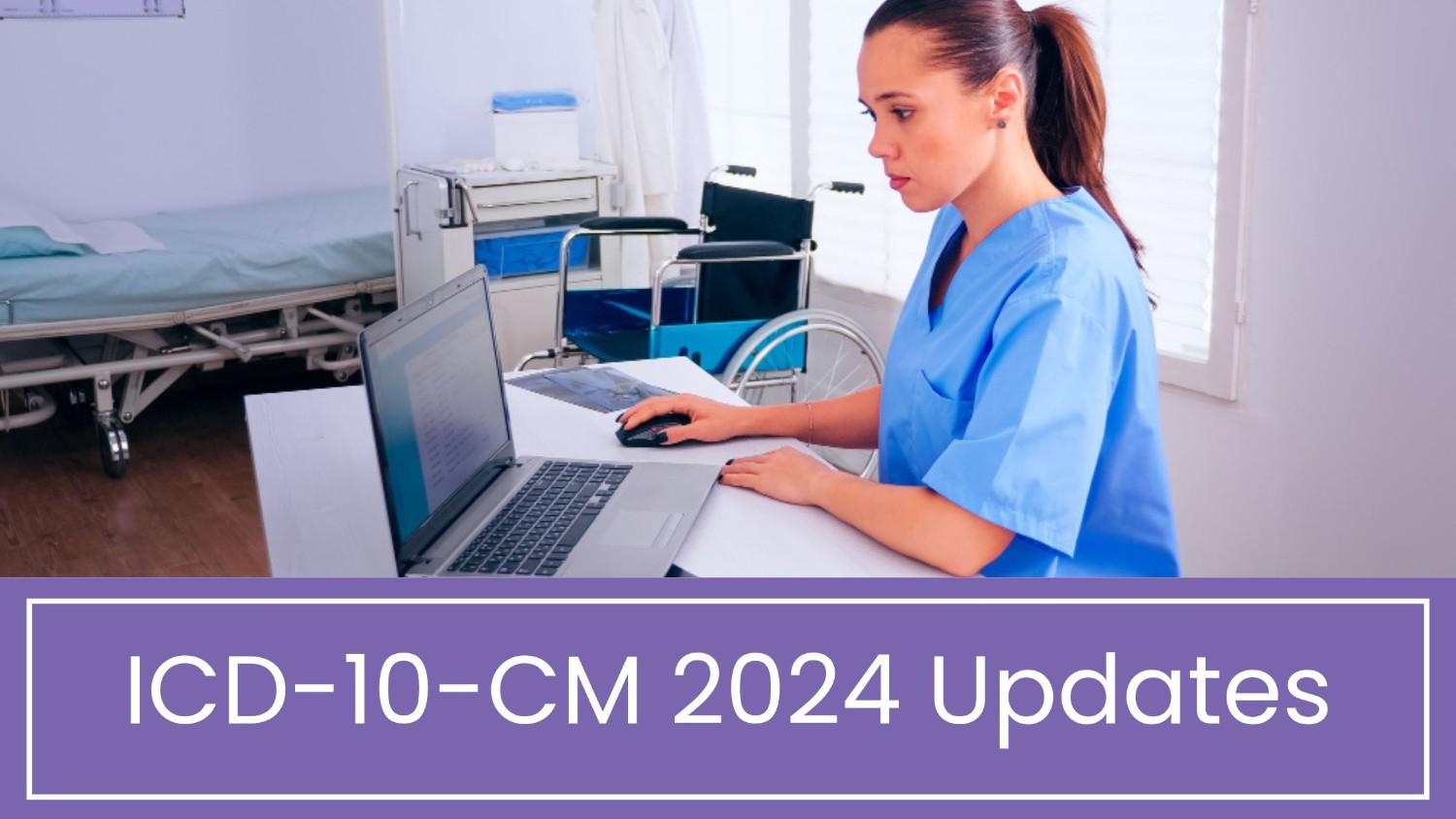ICD-10-CM 2024 Updates part 1
In the ever-evolving landscape of healthcare, staying informed about crucial updates is paramount for healthcare professionals. We will look into the upcoming changes in ICD-10-CM for 2024, in this two-part blog series and also, offer insights into the significant changes that are set to influence the field of medical coding and diagnosis. From infectious diseases to neurological conditions, we will explore the newly introduced diagnostic codes, providing healthcare professionals with essential insights into the evolving terminology and classifications that shape modern healthcare practices. Join us as we embark on a journey through the intricacies of ICD-10-CM 2024 updates, equipping professionals with the knowledge they need to navigate the dynamic world of healthcare coding.
Table of Contents
Understanding ICD-10-CM: A Brief Overview
Before delving into the specifics of the 2024 updates, let’s briefly understand what ICD-10-CM is and why it’s essential. ICD-10-CM is a diagnostic coding system used in the United States to classify and code diseases, conditions, and other health-related issues. It is extremely important in the healthcare industry as it allows for accurate billing, medical research, as well as public health reporting.
ICD-10-CM codes are alphanumeric and are used by healthcare providers to document patient diagnoses, which in turn affect insurance claims, reimbursement, and statistical analysis. Given its pivotal role in healthcare operations, ICD-10-CM is subject to regular updates to ensure it reflects the latest medical knowledge and aligns with evolving clinical practices.
In the 2024 update to the ICD-10 code set, there are notable changes. This update introduces 395 new ICD-10 codes, removes 25 codes, and alters 22 existing ones. These additions and modifications are intended to improve the accuracy of diagnostic coding for various medical conditions. Furthermore, there have been revisions made to 131 code headers, with four of them being modified.
ICD-10-CM 2024 Updates: What’s New?
The ICD-10-CM code set is updated annually, with revisions typically going into effect on October 1st of each year. The ICD-10-CM 2024 updates bring several notable changes that healthcare professionals should be aware of. The majority of the updates to the diagnosis coding guidelines for fiscal year 2024 are chapter-specific. Below are chapter-by-chapter details on how these codes are allocated, as well as an overview of specific conditions:
Chapter 1: Updates to Codes for Infectious and Parasitic Diseases
The update includes the addition of two new codes pertaining to sepsis caused by Acinetobacter baumannii or conditions associated with this pathogen but categorized separately.
- A41.54 – Sepsis due to Acinetobacter baumannii
- B96.83 – Acinetobacter baumannii as the cause of diseases classified elsewhere
Chapter 2: Updates to Neoplasms Codes
The latest update includes the addition of 13 new medical codes, notably encompassing 10 codes specifically designed for the desmoid tumors. This Desmoid tumors, known for their rarity, originate within deep soft tissues as well as within connective tissues and exhibit an unpredictable progression. It’s important to note that desmoid tumors lack the capacity to spread to other parts of the body and are not categorized as cancerous. They are recognized for their tendency to exhibit local aggressiveness, infiltration, and tissue damage. At times, these tumors are known as aggressive fibromatosis, and they have the potential to appear in different parts of the body, including the abdominal wall, extremities and shoulders, pelvic girdles and chest wall, the intraabdominal, retroperitoneal, and pelvic cavities, as well as the regions of the head and neck and the intrathoracic area.
- D13.91 – Familial adenomatous polyposis
- D13.99 – Benign neoplasm of ill-defined sites within the digestive system
- D48.110 – Desmoid tumor of head and neck
- D48.111 – Desmoid tumor of the chest wall
- D48.112 – Desmoid tumor, intrathoracic
- D48.113 – Desmoid tumor of the abdominal wall
- D48.114 – Desmoid tumor, intraabdominal
- D48.115 – Desmoid tumor of the upper extremity and shoulder girdle
- D48.116 – Desmoid tumor of the lower extremity and pelvic girdle
- D48.117 – Desmoid tumor of back
- D48.118 – Desmoid tumor of other site
- D48.119 – Desmoid tumor of unspecified site
- D48.19 – Other specified neoplasm of uncertain behavior of connective and other soft tissue
Chapter 3: Updates to Codes Related to Conditions Impacting the Blood, Organs Responsible for Blood Formation, and Disorders Involving the Immune System Mechanism
The Updates include the addition of eight new diagnostic codes. These new codes are designed to address sickle-cell anemia conditions that are accompanied by dactylitis, a condition characterized by significant swelling and discomfort in the fingers and toes. This phenomenon is commonly observed in infants who are affected by sickle cell anemia.
- D57.04 Hb-SS disease with dactylitis
- D57.214 Sickle-cell/Hb-C disease with dactylitis
- D57.414 Sickle-cell thalassemia, unspecified, with dactylitis
- D57.434 Sickle-cell thalassemia beta zero with dactylitis
- D57.454 Sickle-cell thalassemia beta plus with dactylitis
- D57.814 Other sickle-cell disorders with dactylitis
- D61.02 Shwachman-Diamond syndrome
- D89.84 IgG4-related disease
Chapter 4: Updates to Codes for Endocrine, Nutritional, and Metabolic Diseases
The latest update includes the addition of 18 new codes within the category of endocrine, nutritional, and metabolic diseases. These new codes have been introduced to specifically address conditions such as insulin insensitivity and hypoparathyroidism.
- E20.810 Autosomal dominant hypocalcemia
- E20.811 Secondary hypoparathyroidism in diseases classified elsewhere
- E20.812 Autoimmune hypoparathyroidism
- E20.818 Other specified hypoparathyroidism due to impaired parathyroid hormone secretion
- E20.819 Hypoparathyroidism due to impaired parathyroid hormone secretion, unspecified
- E20.89 Other specified hypoparathyroidism
- E74.05 Lysosome-associated membrane protein 2 [LAMP2] deficiency
- E75.27 Pelizaeus-Merzbacher disease
- E75.28 Canavan disease
- E79.81 Aicardi-Goutières syndrome
- E79.82 Hereditary xanthinuria
- E79.89 Other specified disorders of purine and pyrimidine metabolism
- E88.43 Disorders of mitochondrial tRNA synthetases
- E88.810 Metabolic syndrome
- E88.811 Insulin resistance syndrome, Type A
- E88.818 Other insulin resistance
- E88.819 Insulin resistance, unspecified
- E88.A Wasting disease (syndrome) due to an underlying condition
Chapter 6: Updates on Coding for Nerve System Diseases
Updates in the field of nervous system disorders include the addition of 24 new medical codes. These codes have been specifically created to address conditions like Lafora Body Disease, also known as Lafora progressive myoclonus epilepsy. This neurodegenerative condition is caused by a glycogen metabolism disorder, leading to the buildup of abnormal glycogen clusters that form Lafora Bodies within various organs, including the brain, and liver.
In addition, the latest update includes the incorporation of four new diagnostic codes tailored specifically for chronic migraine with visual disturbances called aura. Additionally, it introduces five new codes designed to cover Parkinson’s disease, encompassing cases both with and without dyskinesia and fluctuations. Parkinson’s disease is a complex progressive neurodegenerative disorder. marked by motor manifestations including bradykinesia, muscle rigidity, tremors, and postural instability. Furthermore, it may also exhibit non-motor symptoms like anxiety and panic attacks, difficulty with executive functioning, and experiencing pain.
- G11.5 Hypomyelination – hypogonadotropic hypogonadism – hypodontia
- G11.6 Leukodystrophy with vanishing white matter disease
- G20.A1 Parkinson’s disease without dyskinesia, without mention of fluctuations
- G20.A2 Parkinson’s disease without dyskinesia, with fluctuations
- G20.B1 Parkinson’s disease with dyskinesia, without mention of fluctuations
- G20.B2 Parkinson’s disease with dyskinesia, with fluctuations
- G20.C Parkinsonism, unspecified
- G23.3 Hypomyelination with atrophy of the basal ganglia and cerebellum
- G31.80 Leukodystrophy, unspecified
- G31.86 Alexander disease
- G37.81 Myelin oligodendrocyte glycoprotein antibody disease
- G37.89 Other specified demyelinating diseases of the central nervous system
- G40.C01 Lafora progressive myoclonus epilepsy, not intractable, with status epilepticus
- G40.C09 Lafora progressive myoclonus epilepsy, not intractable, without status epilepticus
- G40.C11 Lafora progressive myoclonus epilepsy, intractable, with status epilepticus
- G40.C19 Lafora progressive myoclonus epilepsy, intractable, without status epilepticus
- G43.E01 Chronic migraine with aura, not intractable, with status migrainosus
- G43.E09 Chronic migraine with aura, not intractable, without status migrainosus
- G43.E11 Chronic migraine with aura, intractable, with status migrainosus
- G43.E19 Chronic migraine with aura, intractable, without status migrainosus
- G90.B LMNB1-related autosomal dominant leukodystrophy
- G93.42 Megaloencephalic leukoencephalopathy with subcortical cysts
- G93.43 Leukoencephalopathy with calcifications and cysts
- G93.44 Adult-onset leukodystrophy with axonal spheroids
Chapter 7: Updates to Codes for Eye and Adnexal Diseases
The latest revision in the classification of diseases affecting the eye and its associated structures includes the incorporation of 34 new medical codes. These newly added codes cover a range of conditions, including sickle-cell retinopathy. Furthermore, this update also includes codes specific to muscle entrapment based on site and codes for symptoms related to foreign body sensations associated with eye and adnexal conditions.
- H36.811 Nonproliferative sickle-cell retinopathy, right eye
- H36.812 Nonproliferative sickle-cell retinopathy, left eye
- H36.813 Nonproliferative sickle-cell retinopathy, bilateral
- H36.819 Nonproliferative sickle-cell retinopathy, unspecified eye
- H36.821 Proliferative sickle-cell retinopathy, right eye
- H36.822 Proliferative sickle-cell retinopathy, left eye
- H36.823 Proliferative sickle-cell retinopathy, bilateral
- H36.829 Proliferative sickle-cell retinopathy, unspecified eye
- H36.89 Other retinal disorders in diseases classified elsewhere
- H50.621 Inferior oblique muscle entrapment, right eye
- H50.622 Inferior oblique muscle entrapment, left eye
- H50.629 Inferior oblique muscle entrapment, unspecified eye
- H50.631 Inferior rectus muscle entrapment, right eye
- H50.632 Inferior rectus muscle entrapment, left eye
- H50.639 Inferior rectus muscle entrapment, unspecified eye
- H50.641 Lateral rectus muscle entrapment, right eye
- H50.642 Lateral rectus muscle entrapment, left eye
- H50.649 Lateral rectus muscle entrapment, unspecified eye
- H50.651 Medial rectus muscle entrapment, right eye
- H50.652 Medial rectus muscle entrapment, left eye
- H50.659 Medial rectus muscle entrapment, unspecified eye
- H50.661 Superior oblique muscle entrapment, right eye
- H50.662 Superior oblique muscle entrapment, left eye
- H50.669 Superior oblique muscle entrapment, unspecified eye
- H50.671 Superior rectus muscle entrapment, right eye
- H50.672 Superior rectus muscle entrapment, left eye
- H50.679 Superior rectus muscle entrapment, unspecified eye
- H50.681 Extraocular muscle entrapment, unspecified, right eye
- H50.682 Extraocular muscle entrapment, unspecified, left eye
- H50.689 Extraocular muscle entrapment, unspecified, unspecified eye
- H57.8A1 Foreign body sensation, right eye
- H57.8A2 Foreign body sensation, left eye
- H57.8A3 Foreign body sensation, bilateral eyes
- H57.8A9 Foreign body sensation, unspecified eye
Chapter 9: Updates to Codes for Circulatory System Diseases
The latest update includes 10 new codes, including ones designed to cover a range of conditions like tachycardia (rapid heart rate), angina (chest pain), and microvascular dysfunction.
- I1A.0 Resistant hypertension
- I20.81 Angina pectoris with coronary microvascular dysfunction
- I20.89 Other forms of angina pectoris
- I21.B Myocardial infarction with coronary microvascular dysfunction
- I24.81 Acute coronary microvascular dysfunction
- I24.89 Other forms of acute ischemic heart disease
- I25.85 Chronic coronary microvascular dysfunction
- I47.10 Supraventricular tachycardia, unspecified
- I47.11 Inappropriate sinus tachycardia, so stated
- I47.19 Other supraventricular tachycardia
Chapter 10: Updates Regarding Codes for Respiratory System Diseases
The update includes seven new codes, specifically designed to address conditions like pneumonia caused by Acinetobacter baumannii and lung allograft dysfunction.
- J15.61 Pneumonia due to Acinetobacter baumannii
- J15.69 Pneumonia due to other Gram-negative bacteria
- J44.81 Bronchiolitis obliterans and bronchiolitis obliterans syndrome
- J44.89 Other specified chronic obstructive pulmonary disease
- J4A.0 Restrictive allograft syndrome
- J4A.8 Other chronic lung allograft dysfunction
- J4A.9 Chronic lung allograft dysfunction, unspecified
These updates in ICD-10-CM for 2024 reflect the ongoing efforts to provide precise coding and documentation standards in the ever-evolving field of healthcare. Further, ICD-10-CM changes will be covered in Part 2 of this blog series. Don’t miss out, make sure to read Part 2!
* For more information, you can refer to the links below:
Centers for Medicare & Medicaid Services (CMS) (or) Centers for Disease Control and Prevention (CDC)*
ALSO READ – Why Upcoding and Downcoding Can Make or Break Your Revenue?
Talk to Medical Billing Expert Today — Get a Free Demo Now!






